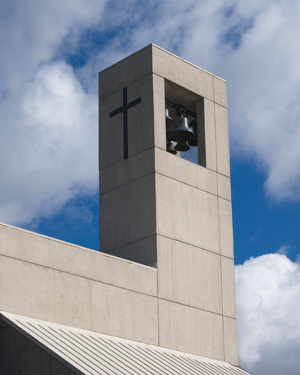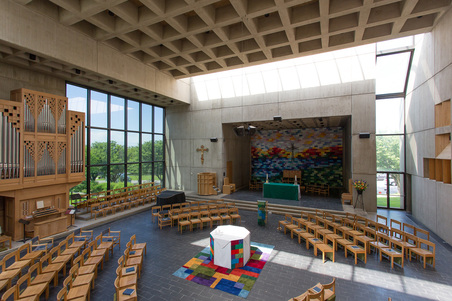About St. Paul's Cathedral

St. Paul’s Church was organized in 1830, when Burlington’s population was about 3,500. About 55 Episcopalians met at a local hotel and laid the groundwork for the parish. The first service was conducted on June 12, 1831, in the old Court House. In 1832, the fledgling parish dedicated its new building, a neo-Gothic limestone structure. Under the leadership of the Rt. Rev. John Henry Hopkins, Bishop of Vermont and Rector of St. Paul’s Parish, the church grew, as it did under his several successors.
In 1851, again in 1866, and – after a fire – in 1910, the building was enlarged. The mid-20th century was, for St. Paul’s as for numerous other Episcopal parishes, a time of explosive growth. In 1965, the Diocesan Convention, meeting at St. Michael’s, Brattleboro, voted that St. Paul’s Church be designated the Cathedral Church of the Diocese.
After having served as a home to Episcopalians in Burlington for nearly 140 years, it was destroyed by fire in February, 1971. This traumatic event was met with both grief and a resolve to renew the whole life of the Cathedral, together with the rebuilding of its fabric. At the time of the fire, the City of Burlington was engaged in massive urban renewal projects. As a part of this program, the City offered to swap the land on which Old St. Paul’s had stood for a spacious new tract overlooking Lake Champlain and the Adirondacks. Although the decision to change locations was a contentious one, the parish’s extensive deliberations led to the decision to accept the city’s offer.
In 1851, again in 1866, and – after a fire – in 1910, the building was enlarged. The mid-20th century was, for St. Paul’s as for numerous other Episcopal parishes, a time of explosive growth. In 1965, the Diocesan Convention, meeting at St. Michael’s, Brattleboro, voted that St. Paul’s Church be designated the Cathedral Church of the Diocese.
After having served as a home to Episcopalians in Burlington for nearly 140 years, it was destroyed by fire in February, 1971. This traumatic event was met with both grief and a resolve to renew the whole life of the Cathedral, together with the rebuilding of its fabric. At the time of the fire, the City of Burlington was engaged in massive urban renewal projects. As a part of this program, the City offered to swap the land on which Old St. Paul’s had stood for a spacious new tract overlooking Lake Champlain and the Adirondacks. Although the decision to change locations was a contentious one, the parish’s extensive deliberations led to the decision to accept the city’s offer.

Dean (later Bishop) Robert S. Kerr and Miss Barbara Ward provided careful and skilled leadership as the Cathedral set about planning for a new building. There emerged a strong desire to make a new statement in architecture. The prevalent feeling was that the new Cathedral building ought both to redefine what a cathedral should look like, and to return to medieval ideas about the vital role of the cathedral in its city. It should be home to the fine and performing arts; it should be the site of lectures and discussions on the great issues of the day; it should welcome and embrace its city and its world; it should invite lively participation of Vermont Episcopalians as well as people of other faith traditions; and it should avoid becoming a museum of artifacts and memorial tablets.
An international competition was held to determine the architect of the new Cathedral. The winner was the local firm Burlington Associates, with Bill Henderson and Tom Cullins as lead designers. The new building was dedicated in two days of festivities, in November of 1973.
The Cathedral is made of stressed concrete. Its plain interior is warmed by white oak furnishings and paneling, and a slate floor; the neutral tones of concrete allow colorful vestments and liturgical action to stand out vividly. Light floods in from skylights and vast curtain windows – including the south wall’s great window, which allows a panoramic view of Lake Champlain and the Adirondacks.
The tower holds a chime of eight bells, cast in 1895 by the Meneely Bell Company of Troy, New York. Cast for Old St. Paul’s, after the 1971 fire they were refurbished and rehung in the new building; a ninth bell was cracked in the fire, and it is now near the main entrance at the base of the bell tower.
The Memorial Garden, an oasis of calm and beauty on the east side of the nave, dates from the 1970s. In it are interred the ashes of numerous members and friends of St. Paul’s. The stonework that encloses the garden incorporates stones from Old St. Paul’s.
The organ, designed and built for the new Cathedral in 1973 by Karl Wilhelm of Mont St-Hilaire, Quebec, is a neo-classic style tracker-action instrument of two manuals and 24 stops. Since its dedication in 1973, St. Paul’s Cathedral has dwelled in the tension of a dual identity: we are both a parish church and the Diocesan Cathedral. Our call is to the pastoral realities of the parish, as well as to service in and hospitality to the larger Diocese.
An international competition was held to determine the architect of the new Cathedral. The winner was the local firm Burlington Associates, with Bill Henderson and Tom Cullins as lead designers. The new building was dedicated in two days of festivities, in November of 1973.
The Cathedral is made of stressed concrete. Its plain interior is warmed by white oak furnishings and paneling, and a slate floor; the neutral tones of concrete allow colorful vestments and liturgical action to stand out vividly. Light floods in from skylights and vast curtain windows – including the south wall’s great window, which allows a panoramic view of Lake Champlain and the Adirondacks.
The tower holds a chime of eight bells, cast in 1895 by the Meneely Bell Company of Troy, New York. Cast for Old St. Paul’s, after the 1971 fire they were refurbished and rehung in the new building; a ninth bell was cracked in the fire, and it is now near the main entrance at the base of the bell tower.
The Memorial Garden, an oasis of calm and beauty on the east side of the nave, dates from the 1970s. In it are interred the ashes of numerous members and friends of St. Paul’s. The stonework that encloses the garden incorporates stones from Old St. Paul’s.
The organ, designed and built for the new Cathedral in 1973 by Karl Wilhelm of Mont St-Hilaire, Quebec, is a neo-classic style tracker-action instrument of two manuals and 24 stops. Since its dedication in 1973, St. Paul’s Cathedral has dwelled in the tension of a dual identity: we are both a parish church and the Diocesan Cathedral. Our call is to the pastoral realities of the parish, as well as to service in and hospitality to the larger Diocese.
